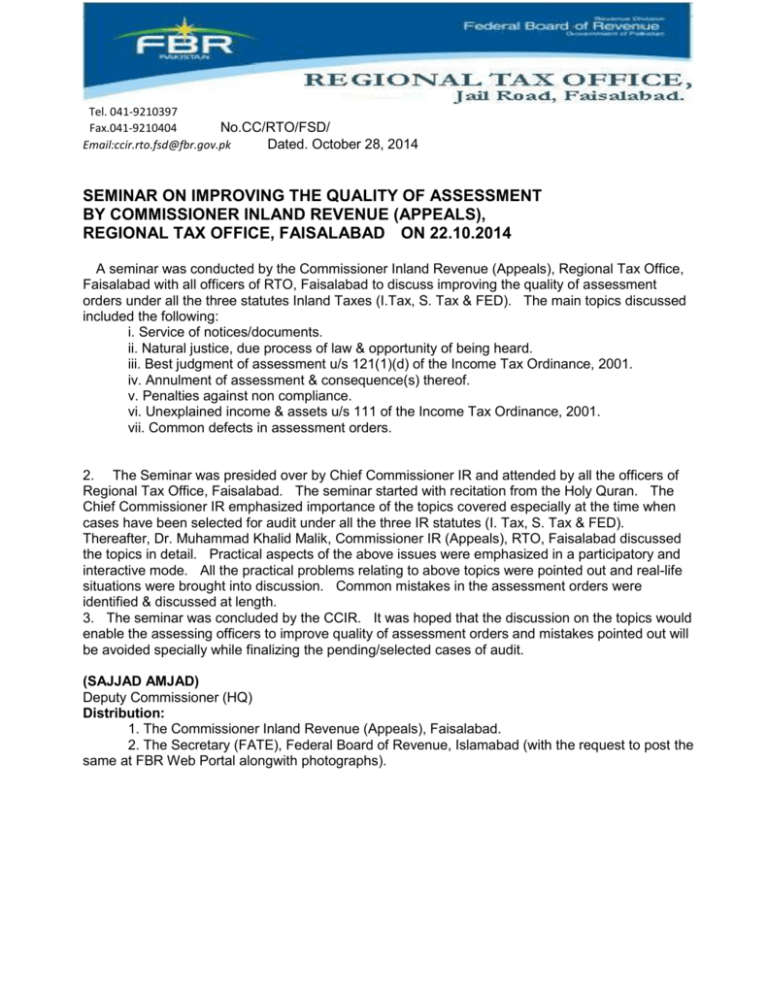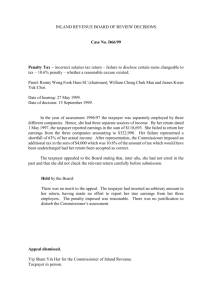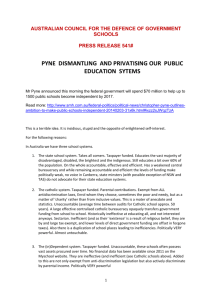seminar on improving the quality of assessment by commissioner
advertisement

Tel. 041-9210397 Fax.041-9210404 No.CC/RTO/FSD/ Email:ccir.rto.fsd@fbr.gov.pk Dated. October 28, 2014 SEMINAR ON IMPROVING THE QUALITY OF ASSESSMENT BY COMMISSIONER INLAND REVENUE (APPEALS), REGIONAL TAX OFFICE, FAISALABAD ON 22.10.2014 A seminar was conducted by the Commissioner Inland Revenue (Appeals), Regional Tax Office, Faisalabad with all officers of RTO, Faisalabad to discuss improving the quality of assessment orders under all the three statutes Inland Taxes (I.Tax, S. Tax & FED). The main topics discussed included the following: i. Service of notices/documents. ii. Natural justice, due process of law & opportunity of being heard. iii. Best judgment of assessment u/s 121(1)(d) of the Income Tax Ordinance, 2001. iv. Annulment of assessment & consequence(s) thereof. v. Penalties against non compliance. vi. Unexplained income & assets u/s 111 of the Income Tax Ordinance, 2001. vii. Common defects in assessment orders. 2. The Seminar was presided over by Chief Commissioner IR and attended by all the officers of Regional Tax Office, Faisalabad. The seminar started with recitation from the Holy Quran. The Chief Commissioner IR emphasized importance of the topics covered especially at the time when cases have been selected for audit under all the three IR statutes (I. Tax, S. Tax & FED). Thereafter, Dr. Muhammad Khalid Malik, Commissioner IR (Appeals), RTO, Faisalabad discussed the topics in detail. Practical aspects of the above issues were emphasized in a participatory and interactive mode. All the practical problems relating to above topics were pointed out and real-life situations were brought into discussion. Common mistakes in the assessment orders were identified & discussed at length. 3. The seminar was concluded by the CCIR. It was hoped that the discussion on the topics would enable the assessing officers to improve quality of assessment orders and mistakes pointed out will be avoided specially while finalizing the pending/selected cases of audit. (SAJJAD AMJAD) Deputy Commissioner (HQ) Distribution: 1. The Commissioner Inland Revenue (Appeals), Faisalabad. 2. The Secretary (FATE), Federal Board of Revenue, Islamabad (with the request to post the same at FBR Web Portal alongwith photographs). 1 IMPROVING QUALITY OF ASSESSMENT ORDERS 2 DR. KHALID MALIK Commissioner (Appeals) MBBS Allama Iqbal Medical College, Lahore LLM (Intl’l Economic Law) University of Warwick, 3 UK FOR WHOM WE WRITE ASSESSMENT ORDERS? 4 taxpayer and ARs Appellate authorities Authorities within IRS: Successor Addl CIR [Amendt u/s 122(5A)] CIR [Revision u/s 122A & 45A] FBR [u/s 214B & 45A] Internal Audit I&I Authorities outside IRS: External Audit FTO President 5 Sequence • • • • • • • Service of notice Opportunity of being heard best Judgement u/s 121(1)(d) annulment of asst and consequences Penalties deemed income u/s 111 common defects in assessment orders 6 SERVICE OF NOTICE 7 Legal provisions (1)Section 218 of Income Tax Ordinance, 2001 (2) section 56 of Sales Tax Act, 1990 (3) section 47 of FED Act, 2005 (4) Rule 74 of IT Rules, 2002 (5) Order V of CPC, 1908 8 ON WHOM? Status Person for service Individual Individual himself Non-individual Representative 9 Representatives sections 172 & 58A Person Representative Company Principal Office [u/s 2(44A) of IT Ord] AOP Principal Office [u/s 2(44A) of IT Ord] Firm Any partner Trust Any trustee Federal Govt. Any individual responsible for accounting for receipts of moneys of funds on behalf of Govt. Provincial Govt. -do- Local Govt -do- 10 a director, a manager, secretary, agent, accountant or any similar officer any person connected with the management or administration of the company or AOP upon whom the Commissioner has served a notice of treating him as the principal officer thereof [u/s 2(44A) of IT Ord] 11 HOW? 1) Personal service 2) postal or courier service 3) service by affixation 4) substitutive service 12 Personal service (1) Individual taxpayer Only on taxpayer personally (2) non-individual taxpayer On representatives 13 postal or courier service Mode: Registered post or courier Sent to:1) individual’s usual or last known address in Pakistan; 2) registered office or address for service of notices under this Ordinance in Pakistan 3) any office or place of business of the person in Pakistan 14 substitutive service 1)Electronic Communication: Email, telephone, telegram 1) publication in press 2) beat of drum 3) any other mode the Court may deem fit 4) service by affixation 15 SERVICE BY AFFIXATION 16 When taxpayer cannot be found out even after repeated visits by N/S -ORWhen he refuses to receive N/S to visit again and again & make enquiries about whereabouts Detailed report to be submitted to Assessing Officer (AO) narrating his efforts for service and reasons for non-service satisfaction of AO that service is not possible in ordinary manner 17 order to effect the service by affixation Notice to be affixed on:(i) on outer door or conspicuous part of the house of business premises (ii) a copy to be posted on notice board Office copy to bear signatures of two witnesses with CNIC Report of IIR: (a) circumstances of service (b) time and date (c) identification of the house 18 AO to satisfy himself that notice by affixation served IIR to be examined on oath by AO 19 e-service of notice U/R 74 (1) e-doc considered served, if sent on e- address notified by taxpayer (1) e-doc considered served to e- address, if sender receives:(a) In case of facsimile number, confirmation from the sending facsimile machine that transmission sent (b) In case of email, confirmation from server of the recipient that the msg has been received (c) From FBR, digitally signed e-mail acknowledgment receipt of return or WH statement (3) e-address: fascimille number or email (4) document: notice, order or requsition 20 Electronic service of notice Rule 74 of IT Rules, 2002 (1)e-doc considered served, if sent on e- address notified by taxpayer (2) e-doc considered served to e- address, if sender receives:(a) In case of facsimile number, confirmation from the sending facsimile machine that transmission sent (b)In case of email, confirmation from server of the recipient that the msg has been received (c) From FBR, digitally signed e-mail acknowledgment receipt of return or WH statement 21 How to ensure proper service training of NS & IIR identify representative for servic simultaneous use of different modes of service (i) personal service on taxpayer (ii) personal service on AR (iii) email to taxpayer (iv) email to AR (v) fax to taxpayer and AR (vi) postal service Service by affixation where so warranted 22 Record all such events of service on Order Sheet prints of online tracking of postal service & POF Print Emails & POF 23 Opportunity of being heard Audi Alteram Partem 24 [hear the other side] The Hearing Rule: taxpayer be provided reasonable time & adequate opportunity of being heard The Bias Rule: no predetermined, preconceived intentions The Evidence Rule: decision must be based upon logical proof or evidence material. 25 • • • • • Procedural fairness Objective decision making process Fair decision Quasi-judicial proceedings No extraneous influence:CIR or AdCIR External audit Internal Audit I&I Complaint CREST 26 • opportunity of being heard to be provided even when certain provision of law does not specifically requires e.g sections 121, 122C, 205 of income tax • reasons for non-acceptance of the declared version • basis for amendment u/s 122 or for estimation/asst u/s 121 • Addition based on issues not confronted— not sustainable 27 How much is too much? variable from case-to-case at least 2-3 notices with 7-10 days compliance time before ex parte decision 28 BEST JUDGEMENT ASSESSMENT U/S 121 Ex Parte Assessment 29 When: failure to provide books of account or any other document or evidence failure to file wealth statement Procedural aspects: notice u/s 121(1)(d)--- must (though specifically not provided in the section) to be finalised on the due date of hearing (and not on any subsequent date) 30 mandatory obligation of AO, despite use of word “may” cannot be equated with “ex parte” proceedings under civil law The object and the purpose: to arrive at a fair and proper estimate of the turnover and income best judgment assessment and not penal assessment (not retaliatory, vindictive, capricious or even arbitrary) [(1985) 51 Tax 181 (SC Pak)] Prefer phrase “best judgment” to “Ex parte” asst 31 Amendment v assessment not discretionary but based on best judgment and documents available on record penalty Para to be included in the body of AO Speaking order basis of assessment must be communicated and discussed in the body of assessment order 32 Basis of assessment taxpayer’s own documents where partial compliance made taxpayer’s own history parallel cases 3rd party information work back of withholding tax like that on cash withdrawal comparison with sales tax returns industrial notes input (wages, electricity, raw material consumed, gas) vis-à-vis output 33 capital vis-à-vis turnover average stock vis-à-vis turnover aggregate credit entries and peak credit entry in bank account statement any inference from wealth statement or wealth reconciliation statement any information on personal expenditure settled commercial practices 34 Commercial practices processing receipts = 4 times consumption of gas retail sale= 5 times rotation of average stock wholesale=10-11 times rotation of average stock GP Rates NP Rates Formula assessments: o ice factory and cold storage o bricks kiln o oil mill 35 o Flour mill open-ended use of best judgement credit side of trading account debit side of P&L a/c where P&L a/c furnished, head-wise disallowance with reasons e.g. Telephone Personal and non-business use by proprietor Vehicle running -do- stationery Excessive, unvouched, unverifiable salary Disallowed u/s 21(l) Rent Disallowed u/s 21(c) Add any other legal addition like: o u/s 111 o u/s 39(3) o u/s 34(5) 36 Sample best judgment ASST. Amount (Rs.) 1 Sales estimated 5,000,000 2 GP assessed @ 15% Less GP declared Trading addition (4-5) Additions out of P&L a/c (head-wise) Add addition u/s 111(1)(b) Add addition u/s 39(3) Total additions [5+6+7+8] Add declared income Income assessed 750,000 (430,000) 320,000 150,000 300,000 500,000 1,270,000 560,000 1,830,000 37 4 5 6 7 8 9 10 11 ANNULMENT OF ASSESSMENT 38 Situations warranting annulment of asst time barred wrong person assessed wrong tax period or year assessed proper opportunity of being heard not provided non-observance of mandatory legal conditions 39 Remedial measures after annulment no difference b/w annulment, cancellation and setting aside annulment is equal to “remand back” except when because of limitation. “Barring some cases, annulled asst can also be taken up if not hit by limitation” FBR’s letter C. No.1(3)DT-14/91 dated 26.05.1991 Fresh proceedings can be undertaken after annulment [2013 PTD 1181 (Trib)] 40 41 tax Penalty Nature Civil liability Criminal liability purpose Source of revenue Instrument of compliance Mens rea Not necessary mandatory Onus probandi On taxpayer and Deptt On Deptt 42 Actus reus ("guilty act“) when proved in combination with the“mens rea”( "guilty mind“) produces criminal liability 43 Remember • • • • assessment and penalty proceedings are separate. Penalty para in the body of assessment order mens rea mandatory for penalty opportunity of being heard mandatory 44 SECTION 111 45 Unexplained cash credit in books of account [section 111(1)(a)] Any amount is credited in a person’s books of account; and •The person offers no explanation about and source of cash credit; or • his explanation is unsatisfactory in opinion of CIR 46 Purpose of the provision: to restrict/control taxpayers’ attempt to introduce their unaccounted income/black money Under the guise of outside depositors (Agriculturists, Non-tax payers, person having exempt income and other such persons) whose genuineness, capacity and creditworthiness is required to be proved beyond reasonable doubts. 47 3-ingadients for making addition:- a. an amount is credited b. in books of account of taxpayer c. taxpayer offers no explanation or unsatisfactory explanation 48 1) Books of accounts It means books of a/c maintained by taxpayer and not any such book maintained by any other person bank account statement is not book of taxpayer existence of books of a/c maintained by taxpayer is pre-condition 49 2) Amount credited amount credited in books of a/c existence of credit entry in books is precondition represents income of taxpayer in absence of any other source of income of taxpayer 50 3) Nature and source exact nature of the credit entry genuineness of transaction source of credit entry: i) Identity: names, addresses, NTN ii) supporting documentary evidence iii) production of such person creditworthiness of such person 51 4) Onus probandi 1) On taxpayer: primary onus on the taxpayer to prove the source of a sum of money found to have been received by him. 2) On Deptt: after furnishing the explanation by taxpayer 52 5) No explanation statutory presumption in the event of unsatisfactory explanation of cash Credits is that these amounts represent taxpayer’s own undeclared/unaccounted for income AO justified to draw an inference that the receipts are of an income nature no onus on Deptt locate the exact source of the cash credits 53 6) Unsatisfactory explanation The satisfaction of the AO – basis of invocation of his powers such satisfaction must not be imaginative but derived from relevant facts and factors, and is on the basis of proper enquiry of all material before him Examination of relevant record and documents enquiries and investigations summoning relevant persons 54 Unexplained expenditures u/s 111(1)(d) 55 it must have incurred must be exact (not hypothetical estimate) onus on Deptt whether suppressed Purchases warrant addition under this section? 56 Quadruple conditions u/s 111(4)a) foreign exchange remitted from abroad through banking channel encashed in Pak Rupees 57 Common in the assessment orders 58 o service of notice defective o opportunity of being heard not proper Simultaneously invoking different provisions: osection 11(2) & (3) are invoked simultaneously o asst finalised u/s 121(1)(d) after issuance of notice u/s 122 and vice versa. Issues relating to dates: o best judgment assessment u/s 121 is finalised on the date subsequent to the date of compliance of notice o Date of order on 1st page and date of despatch on last page of ONO are different 59 oapproval for condonation by CIR under Sales Tax Act, 1990 not discussed in the body of order o Subsection of 11 of ST Act not identified o subsections of section 122(5) and 111(1) of IT Ord are not identified olumpsum additions made out of P&L exp o nature of business not discussed o declared results not made part of Order o long time-lag b/w issuance of order and its service 60 What Next? Amendment u/s 122 Recharacterization u/s 109 Conductance and conclusion of audit where books of account are produced 61 62








